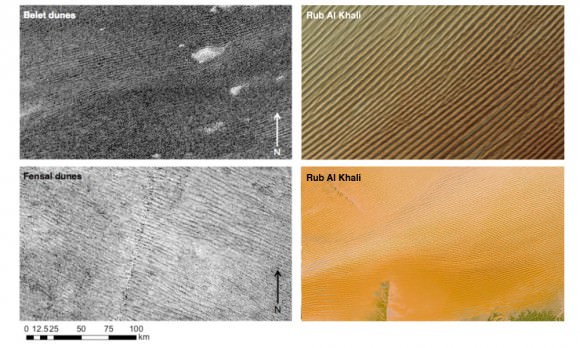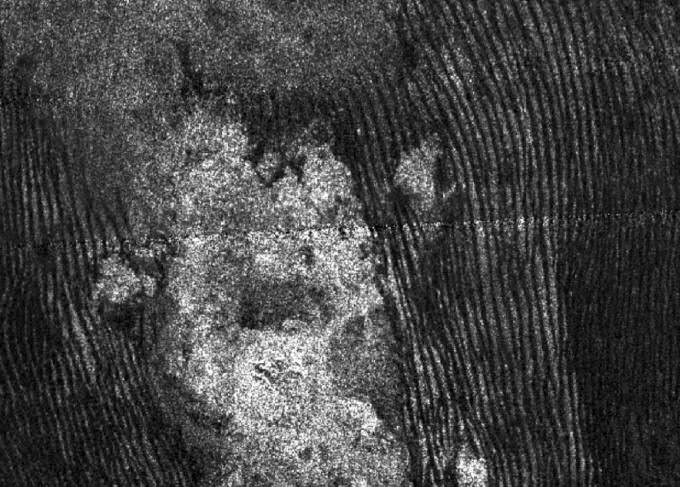[/caption]
Titan is a world that is amazingly Earth-like in some ways, with rain, rivers, lakes and seas. Mind you, the liquid in this case is methane/ethane instead of water, at the bitterly cold conditions on the surface. Also like Earth, Titan has vast sand dune fields, covering about 10 million square kilometres (39 million square miles), or 13% of Titan’s surface. The Cassini spacecraft has been studying these dunes with its radar (in order to see through the perpetually smog-like atmosphere), with interesting results.
Titan’s dunes show regional differences, although they are only found in equatorial areas, between 30°S and 30°N. They are found in both highlands and lowlands, but primarily in lower elevations. The ones at higher altitudes are thinner and more widely spaced, and the gaps between them are brighter in the radar images, which means that there is probably less sand available than at lower altitudes. The dunes also become narrower and more widely spaced at northern latitudes.

Because Titan’s southern hemisphere has shorter but more intense summers, due to Saturn’s elliptical orbit around the Sun, there is less moisture in the soil in those regions, making them more ideal for dune-forming. There is more moisture in the northern regions, where most of the lakes and seas are found.
“As one goes to the north, the soil moisture probably increases, making the sand particles less mobile and, as a consequence, the development of dunes more difficult,” said Dr. Le Gall of LATMOS-UVSQ in Paris.
The characteristics of Titan’s dunes also provide clues to the moon’s climate and geological history.
According to Nicolas Altobelli, Cassini–Huygens project scientist, “Understanding how the dunes form as well as explaining their shape, size and distribution on Titan’s surface is of great importance to understanding Titan’s climate and geology. As their material is made out of frozen atmospheric hydrocarbons, the dunes might provide us with important clues on the still puzzling methane/ethane cycle on Titan, comparable in many aspects with the water cycle on Earth.”
It should also be noted that the sand on Titan is composed of solid hydrocarbons instead of silicates like sand on Earth. Similar in appearance, but like the rest of Titan, very different in composition. They are reminiscent of the dune fields in Namibia or southern Arabia, but are much larger – they average about 1-2 kilometres (0.6-1.2 miles) wide, 100 metres (328 feet) tall and extend for hundreds of kilometres/miles!
It would be interesting to see a Titanian version of Lawrence of Arabia…


As noted, the “sand” on Titan is very different than the (rock and mineral) sand we find on Earth. What is the average size of sand particles on Titan? Is it closer to silt or gravel in appearance?
According to JPL: